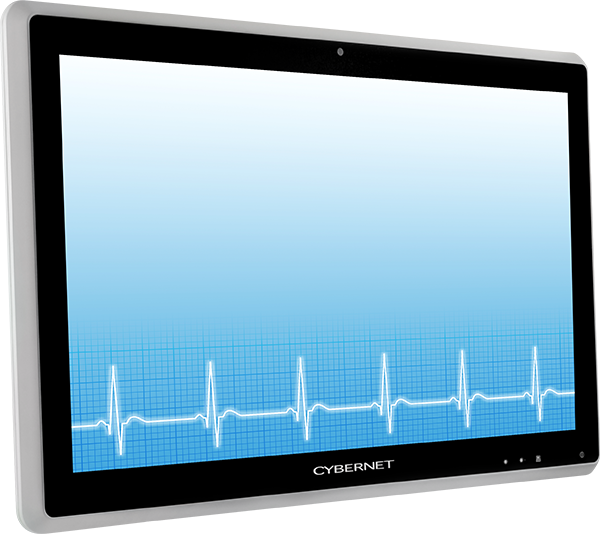In 1895, physicist Wilhelm Röntgen revolutionized the field of medicine when he inadvertently created the world's first radiographic image by passing his hand in front of a cathode ray tube. Today, more than a century later, digital technology allows doctors to capture diagnostic images with a level of clarity that Röntgen could only imagine. Unfortunately, a digital image is only as clear as the monitor it's displayed on. Outdated and subpar displays can obscure important details, leading to misdiagnosis, delayed treatment, and even death. Thankfully, the right medical grade monitor can help medical professionals avoid these pitfalls.
But choosing the RIGHT medical monitor for your facility's particular needs can be a daunting task. No single monitor is perfect for every application, and the available options can be confusing to people without an extensive background in AV tech. That's why we at Cybernet have identified four key factors to consider when choosing a medical monitor for diagnostic image: Image Clarity, Practicality, Safety, and Privacy.
Image Clarity
It may seem like it goes without saying, but the most important thing to consider when looking for a medical grade monitor for diagnostic imaging is image clarity. After all, an accurate diagnosis can represent the difference between life and death. That's why radiologists need monitors capable of displaying every minute detail of the image or scan they are examining.
But how do you know that a given monitor is up to snuff? The first factor to consider is the display's resolution. Medical grade monitors come in a variety of resolutions, from 1280 x 1024, to 1080p, all the way up to 4k. 4K radiology medical monitors, aimed for imaging and PACS use, contain twice as many pixels per square inch as their 1080p counterparts and are capable of displaying images with unparalleled detail.
However, not every facility is in the position to deploy a fleet of 24 inch 4K medical monitors, nor is every 4k display created equal. After identifying what resolution your facility needs out of its medical grade monitors, the next factor to consider is dynamic range. Dynamic range refers to a monitor's contrast - in other words, the monitor's ability to retain details in very bright and very dark parts of an image.
Monitors with low dynamic range flatten the difference between dark grays and blacks and blow out highlights such that they all appear white. Since many diagnostic images, such as mammograms and x-rays, are in greyscale, a display with poor dynamic range can obscure important details and can lead to misdiagnosis or worse. Medical grade monitors, on the other hand, boast contrast ratios as high as 3000:1, meaning that every little shade of detail will be visible on every image they display.
Practicality
After image quality, the next most important factor to consider when looking for a medical grade monitor to use for diagnostic imaging is practicality. After all, a monitor that displays crystal clear, high-resolution images is useless if it doesn't integrate well into your hospital's existing workflows.
Fortunately, most medical grade monitors can be equipped with a number of additional features that radiologists need to do their jobs, including MVA displays and PCAP touchglass. MVA displays allow you to view clear images at extreme angles, while the PCAP touchglass allows radiologists to examine images without ever touching a keyboard or mouse. Medical grade monitors are also VESA mountable, meaning they can easily be installed on most medical carts, display stands, and wall mounts. There are even 4x3 aspect ratio models available for those facilities that need a high-quality display that's compatible with legacy imaging software.
Additionally, unlike most consumer grade displays, battery-powered medical displays can be powered with hot-swappable batteries, making them perfect for non-powered carts. Not only do they supply their own power, but they can also power other peripherals and even the computer itself. That way, high-quality diagnostic images can be pulled up anywhere you need them in the facility, not just at specific designated stations.
Most importantly, unlike consumer grade models, medical grade monitors are highly customizable. That way, you can mix and match features like touchscreen, battery-powered monitors with DC-out capabilities, and privacy filter (which is detailed below) to name a few, to ensure that the displays you deploy are the most practical displays you could possibly have for your facility's needs.
Safety
Patient safety is always a paramount concern when medical facilities purchase new equipment, and medical monitors are no exception. Luckily, medical grade monitors, like medical-grade computers vs off-the-shelf PCs, outperform their consumer grade counterparts in nearly every metric. For instance, unlike the vast majority of consumer grade displays on the market, medical monitors are built with antimicrobial* housing that is able to protect the casing from deterioration and degradation. They are also designed with sealed front bezels and touch glass that allows for easy disinfection, and they are IP65 certified against dust and liquids. Additionally, medical monitors are IEC-60601-1 certified for near-patient use, meaning their radiation levels are extremely low and won't interfere with other critical medical equipment.
Privacy
The final factor to consider when purchasing a medical grade monitor is patient privacy. Patients trust their healthcare providers with extremely personal details about their health and expect their information to be kept safe from prying eyes. Beyond patient expectations, most developed nations have strict healthcare privacy laws that every facility must abide by. Fortunately, medical grade monitors can be upgraded with built-in 3M privacy filters, which make it so that anyone looking at the display from an angle sees a blank screen. In facilities with high patient loads, this helps ensure that only authorized personnel can see people's sensitive diagnostic images.
The Bottom Line
If you're interested in learning more about the advantages that medical grade monitors have over their consumer grade counterparts when it comes to diagnostic imaging, contact the experts at Cybernet today!

